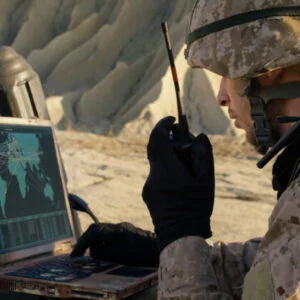The role of technology; communications and networks in particular; in national security and development has assumed critical proportions. At the larger level, technology has been the critical factor in determining a nation’s progress, power, wealth, and the well-being of its citizens. It is a well-established fact that nations that had control over dominant technologies tended to benefit economically. They dominated the world economy as technology gave them an edge in terms of quality of products, control over production processes and hence, world trade. Growth of modern science and technology accelerated with the advent of the knowledge era. The latter half of the 20th century saw the maturing of Information and communication technologies to give rise to profound and innovative impact on war in terms of information dominance, real-time situational awareness, cyber warfare, net-centricity, drones, artificial intelligence, algorithms, and concepts such as swarming. The rise of China and the current strategic conflict with the US is primarily driven by their competition for technology leadership in the 21st century. Communications and network technologies are at the centre-stage of this competition.
Deriving information awareness through communications and functioning through networks are essential aspects of life on earth. Network effects are found in biologically diverse worlds that include molecular bio-chemical reactions, cellular neural networks, insect swarms, and entire ecologies. They are also found in such diverse engineered systems as power grids, communications networks like the Internet, and the transportation infrastructure. Networks effects abound in human social structures. Modern communications have resulted in such significant capabilities that criminal, and terrorist social networks are able to exploit modern communication and transport networks.
Success of military operations depend on effectiveness and tempo of operations, which in turn depend on the ability to create near real-time situational awareness. Development of the Internet, technology breakthroughs in the JTRS (Joint Tactical Radio System) program of the US military, and Walmart’s innovative creation of networked just-in-time inventory management system, all combined to highlight the potential of digital communications and networking in the 1990s. Rapid developments in computing capabilities and networks have validated Moore’s Law – made massive computations cheap, Metcalf’s Law – benefits of connectivity, and Reed’s Law – elevates connectivity to an economic imperative. The development of the SDR (Software Defined Radio) as the centrepiece of military communications and networks leading to the concept of NCW (Network-Centric Warfare) is a breakthrough in modern warfare. In military networks, whether on land, sea, or air, effects occur in the communication systems that link platforms and soldiers, creating static and dynamic networks. Dynamic battlefield networks are built in real-time, relying on more static networks such as physical communications, weapon systems platforms, and military organisational structures. Real-time situational awareness for each platform and individual is critical, and the fusion of multiple sensor inputs to create the real-time composite operational picture for commanders at various levels is critical for effective decision making.
In this communications and network scenario, the challenges of interoperability, that is ability to integrate and maintain connection among different forces are significant. This was a big challenge for the US and the Coalition forces in their operations in Iraq and Afghanistan and led to the development of JNN (Joint Network Nodes) and GIG (Global Information Grid) structures. These allowed for direct connectivity between war fighters of different services, thus enabling brigade and battalion units to stay connected to the JTF (Joint Task Force) in support of their mission. Tactical communications enabled Blue Force Tracker (BFT), which allows war fighters on ground to answer the queries – where am I? where are my buddies? that became significant successes in Iraq and Afghanistan.
Similarly, C4ISR needs to incorporate the key elements of connectivity and interaction in order to avoid being stove piped. To win battles of the future, the integration of C4ISR systems is essential, from concept development to combat in the field.
Where does India stand with respect to these rapid developments in communication and network technologies? The Indian military had begun the process of enabling network-centric capabilities as early as 2001. The Navy was the first to begin work on developing the elements of MDA (Maritime Domain Awareness). The need to monitor both civilian shipping and foreign vessels from a security perspective was the initial driver for subsequent development of the basics of MDA using the HF software radio. This pioneering development was made by DRDO’s Navy-manned research lab – WESEE. The challenge of MDA development was well surmounted as the data handling was lesser due to the limited number of ships, their slower speed of around 30 knots and hence, manageable sampling rates. The MDA is now fully operationalised with further developments that have integrated VHF, maritime air surveillance, airborne datalink, submarines, and the weapon systems. Software Defined Radio (SDR) developed by DEAL, DRDO is now integrated and continues to refine.

The IAF launched its NCW programs almost immediately with the launch of its IACCS (Integrated Air Command and Control System) in 2003, and the more complex ‘airborne datalink’ in 2005. The IAF’s airborne datalink pioneered a forward-looking advanced concept of NCW that is based on self-organising principle of masterless, node less, algorithms using dynamic TDMA communication technologies. This was a considerable technical challenge but was done with foresight as the US, the NATO, and other countries continued to use master-slave format of datalink due to the huge number of legacy systems involved. The IAF’s IACCS and the airborne datalink were technically harmonised. With the operationalisation of the IACCS (both phases), India’s air defence system is comprehensively networked. Much of the IACCS is indigenous although its critical component, the routers are all CISCO based. The IAF validated its ‘airborne data-link’ technology and concepts through a well-crafted pilot project by 2013. The technology partner in this project was ELTA, Israel. The airborne SDR was developed exclusively for the pilot project by ELTA. In order to operationalise its airborne NCW capability, the IAF has imported the first set of 400-odd SDRs from Israel. This integration is way behind schedule and is beset by integration problems on various platforms. SDRs will need to access vast amount of data from various sensors and mission computers of an aircraft, which is difficult without the involvement of the OEM. This is a major problem as it involves technology access, high costs and time frames.
The army’s tactical radio acquisition has been hampered for many years by internal and external factors. India’s cumbersome acquisition process and tedious developmental procedures are to be blamed. More importantly, lack of adequate funding and project accountability have been major problems. Inadequate funding for defence modernisation over the last two decades has forced previous Army chiefs to reprioritise their acquisition plans in favour of immediate weapons requirements like assault rifles. Thus, the Army’s major programs for NCW capability, TCS (Tactical Communication System) and BIS (Battlefield Information System) have been put on the backburner since the last five years. The long-term damage could be immense. Army’s plans for acquiring a large number of tactical radios as part of its TCS has been lingering over the last 6-7 years. The main problem has been Army’s inability to finalise its technical specifications and support indigenous development.
The government has initiated policies to support indigenous development of drones in a big way. However, for the military, control over critical technologies should form the focus of its strategy with respect to drones. As drones become more and more autonomous, the use of satellite-based communications, artificial intelligence, robotics, and swarming algorithms will change the face of future wars and threats in our environment. This is the area that India must invest heavily, both in terms of funding and human resources, to develop significant capabilities rapidly. India is a late starter in Drones, AI and swarming. China, the US, and Russia have a three-decade lead over India. India’s strategic planners must plan to overcome this gap if we are to deter our adversaries. Communication and Network technologies will be the crux of not only future warfare but national and global power as well. Given the recent acrimony over theatre commands, any such venture must be preceded by the operationalisation of communication and network technologies, interoperability, and standardisation protocols.
–The writer is an Air Force veteran and former DCIDS (PP & FD). He is the President of The Peninsula Foundation, Chennai. The views expressed are personal and do not necessarily reflect the views of Raksha Anirveda
–The writer, a AVSM VM PhD (V) is a former Deputy Chief of Integrated Defence Staff for Policy, Plans, & Force Development (DCIDS – PP & FD). He is currently the President of The Peninsula Foundation, a Chennai-based public policy research think tank. The views expressed are of the writer and do not necessarily reflect the views of Raksha Anirveda






